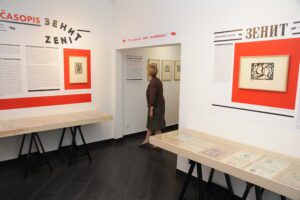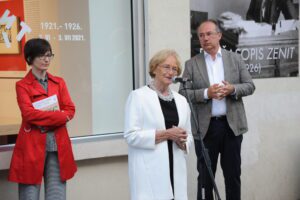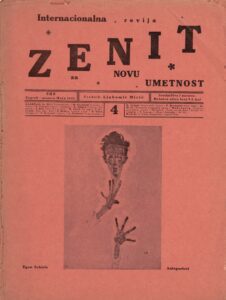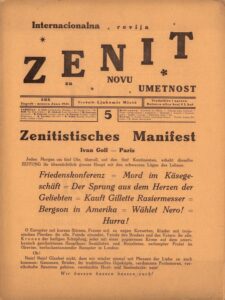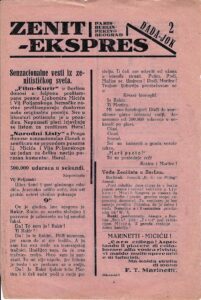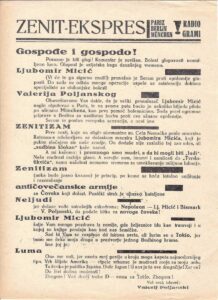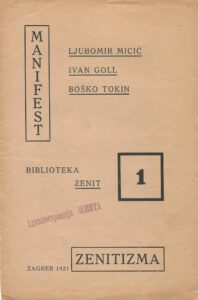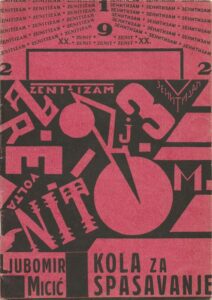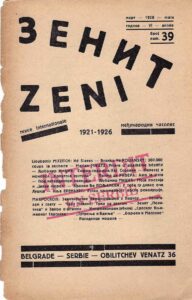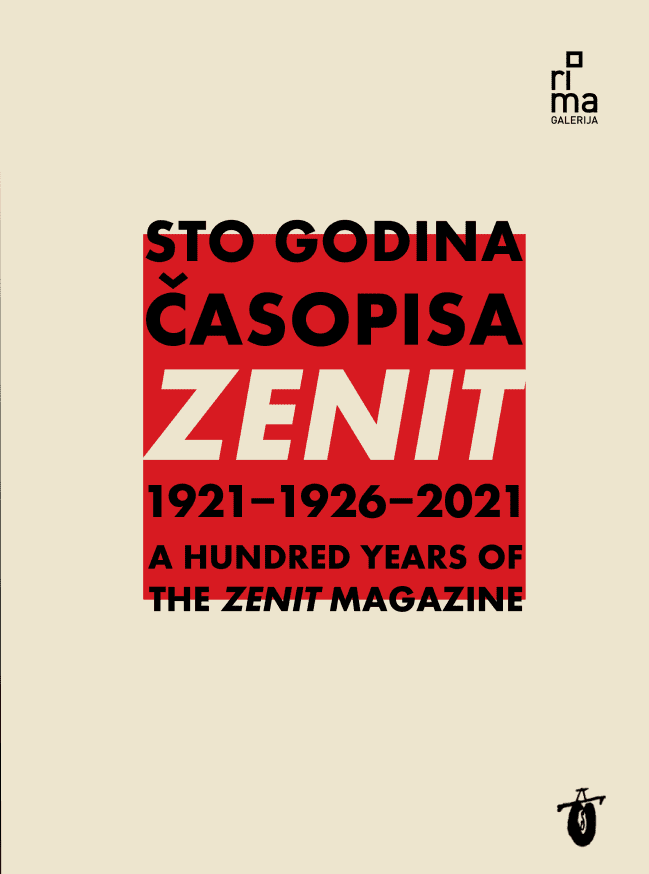Nevena Martinović
Marija Stanković
THE ZENIT MAGAZINE (1921-1926)
A Hundred Years Since the Launching of the Avant-garde Magazine
A full century has passed since 1 February 1921 when the first issue of a new avant-garde magazine Zenit was published in Zagreb. For almost six years Zenit was the creator and promoter of the most modern ideas in Yugoslav culture. Thanks to this journal Zagreb and Belgrade were inscribed for good into the map of radical happenings in culture and art throughout Europe, today embraced by the concept of the historic avant-gardes of the 1920s.
On the first day of February – exactly at the centennial of the first issue of Zenit – Gallery RIMA opens in Belgrade an exhibition dedicated to the history of this avant-garde periodical. The exhibits displayed are composed of the original copies of Zenit, copies of the Zenit editions as well as documentary material related to the zenitist activities.
In cooperation with the Institute for Literature and Art from Belgrade Gallery RIMA has prepared an international scholarly publication A Hundred Years of the Zenit Magazine 1921-1926-2021), edited by Dr Bojan Jović and Professor Emeritus Irina Subotić. With thirty-five studies, numerous documents and visual contributions secured in cooperation with institutions and individuals locally and from abroad, this compilation brings new interpretations and re-evaluations of the historical role and importance of the magazine Zenit.
Gallery RIMA will conclude the celebration of the century-long memory of Zenit by publishing four re-prints of four Zenit publications and of the study written by Dr Vidosava Golubović, a literary historian. This project will make rare and exceptionally important publications accessible to the general public:
- Lj. Micić, I. Goll, B. Tokin, Manifest zenitizma (The zenitist manifesto), Edition Zenit, No. 1, Zagreb, 1921.
- Goll, Paris Brennt, Edition Zenit, No. 2, Zagreb, 1921.
- Lj. Micić, Kola za spasavanje (Life-saving car), Edition Zenit, No. 3, Zagreb-Belgrade, 1922.
- Ve Poljanski, 77 samoubica (77 suicides), Zagreb, 1923.
On the occasion of the Zenit anniversary Gallery RIMA intends to give its own contribution to the activities and material evidence that add new meanings to the existing ones, hoping to enrich the discourse on zenitism, since to write and talk together means to memorise and remember, making the zenitist legacy present today.
ZENIT (1921-1926)
In the years immediately before and after WWI and the October Revolution, the cultural scenes of devastated Europe witnessed the appearance of some radical art developments and movements, such as futurism, dadaism, suprematism, constructivism, surrealism, all of them requiring final settlement or separation from tradition; they were also in search of new forms and contents in art. Although historic avant-gardes did not have a long lifespan, they brought the bravest realisations and the most radical extensions in all areas of art and left behind works and ideas that would inspire numerous phenomena and artists to the present day.
It was exactly in that period of exciting artistic projects and experiments that the magazine Zenit appeared as an International Review for New Art. Zenit was also the only periodical in Yugoslavia in the early twenties which became a part of the international avant-garde stirrings on equal terms. It was published in the Kingdom of Serbs, Croats and Slovenes between 1921 and 1926, with 43 issues in that period: two double issues (17/18/ and 19/20, both in 1922) and a collection of eight issues (26-33, in 1924). The founder and editor-in-chief was a young writer, poet and translator Ljubomir Micić (1895-1971).
While the magazine existed, the editors of Zenit had two headquarters, and according to that fact the history of the magazine is divided into two periods – the period in Zagreb and the one in Belgrade. The magazine was launched in Zagreb and published there between 1921 and 1923, with the issue 24 conclusive. Because of sharp comments directed both to Croatian political officials and renowned personalities in the area of culture, Micić was compelled to move his offices to the capital of the Kingdom of SCS. The Belgrade phase of Zenit lasted from 1923 to 1926. It began with the publishing of a grandiose monograph on Alexander Archipenko in 1923; then followed the issue 25 of Zenit (in February 1924), serving also as a catalogue of the first and only Zenit International Exhibition of New Art organised in April 1924. In a similar way as in the case of the Zagreb phase of the magazine, its Belgrade period was full of misunderstandings, numerous criticisms and thus ended in a conflict with the authorities because of a text published in issue 43, in December 1926 – it was at the same time the last issue of the magazine, and its distribution was not permitted.
The fate of Zenit was closely tied to the uncompromising but hot-tempered personality of Ljubomir Micić who used to criticise in his magazine everything he deemed incorrect, old-fashioned or obsolete in the cultural milieu where he lived. On the other hand, thanks to Micić’s visionary spirit and sharp editorial talent, Zenit was the first to bring into its environment examples of new avant-garde developments in all arts and even broader, in various areas of culture, and thereby directly, in contributions of his local and foreign correspondents who were active protagonists of European cultural and artistic movements.
From the very beginning, the magazine had an outstanding international direction since one of the crucial definitions of the new, avant-garde art was its humanistic and supranational character. The international quality of the magazine is primarily obvious in the circle of personalities whose texts and samples of visual art were published in Zenit. Among over one hundred artists from the whole world and mostly from Europe, there were emblematic names such as W. Kandinsky, A. Blok, V. Mayakovski, I. Ehrenburg, S. Yesenin, L. Trotsky, M. Gorky, V. Tatlin, El Lissitzky, K. Malevich, A. Rodchenko, A. Archipenko, F. T. Marinetti, R. Vasari, S. Pocarini, M. Sauvage, P. Dermée, J. Epstein, A. Modigliani, R. Delaunay, E. Schiele, I. Goll, R. Hausmann, H. Valden, G. Grosz, L. Moholy-Nagy, T. van Doesburg, J. Peeters, V. Gropius, E. Mendelsohn, L. Lozowick, H. Meyer, and others. Certain artists and authors from Yugoslavia, who, Micić believed, shared his visionary ideas and aesthetics beyond the local framework, also belonged to this international collective for shorter or longer periods. Therefore, among the artists and authors from Serbia, Croatia and Slovenia there were: S. Vinaver, B. Tokin, M. Crnjanski, R. Petrović, D. Aleksić, D. Matić, Mih. S. Petrov, R. Drainac, M. Kujačić, J. Bijelić, V. Biler, V. Gecan, V. Foretić, M. Mikac, J. Sajsel/Klek, V. Pilon, and later A. and T.Černigoj, E.Stepančič, F. Delak, among others.
The impressive international circle of co-authors and their, most frequently, original contributions were key indicators of the contemporaneity of Zenit, which, as an avant-garde periodical, participated in parallel with other European magazines of similar intentions (Der Sturm, Die Aktion, L’Esprit nouveau, Le Futurisme, Noi, De Stijl, Merz, Вещь/Objet, Gegenstand, Devĕtsil, MA, Contimporanul, Пламък, etc.) in the shaping of what was ambitiously claimed to be the new art of the entire epoch. The international quality of Zenit was additionally emphasised linguistically since many texts were published in original languages without translation, including Esperanto.
Zenitism
At the same time Zenit played the role of a programmatic periodical in which Micić defined and promoted zenitism, the avant-garde movement whose creator and chief ideologue was he himself. Intending to fully reject tradition and old patterns in all the spheres of creation, zenitism aimed at creating a new art with new forms and contents (in all the areas and existing media: literature, painting, sculpture, graphic print, collage, artistic advertisement, new typography, architecture, music, theatre, film, design, radio). Micić had the idea that all those disciplines should actively participate in the shaping of social reality and lead to a new, more humane era. In that sense, zenitism was founded on a synthesis of the main assumptions of different avant-garde movements of that age. Apart from the conceptual essence, Micić worked diligently on finding zenitist models in various fields of the arts, with accent on poetry and theatre as well as the visual arts. Micić immediately promoted two very young men to programmatic artists of zenitism – first Mihailo S. Petrov, in his early expressionistic phase, while awarding the title of the truly zenitist painter to Josip Seissel, who had been publishing his works in Zenit and exhibited them under the alias Jo or Josif Klek. The graphic design of the magazine has remained until these days the most recognisable manifestation of the zenitist innovation in the area of design. And finally, zenitism fostered all the formal manifestations of an avant-garde movement – the magazine as programmatic periodical – advertising materials (pamphlets, leaflets, posters), zenitist evenings and other public programmes, even politically tinted actions (such as demonstrations against Rabindranath Tagore in Belgrade or the dialogue of Poljanski and Marinetti in Paris). In the network of avant-garde “isms” zenitism was exceptional owing to Micić’s project about the Balkanisation of Europe (instead of Europeanisation of the Balkans) whose main champion would be Barbarogenius – a contemporary spiritual reincarnation of the “HERO MAN prototype from the Southern Balkans”. Micić’s construction of Barbarogenius was a man from the Balkans, unsoiled with European civilisational legacies (which had caused WWI and were destructed in it), the man who has the necessary potential to decivilize the tired, old Europe and transform it by means of his new, pure barbarian power of the spirit and mind.
(Complete text in printed edition)
Artworks
- About


